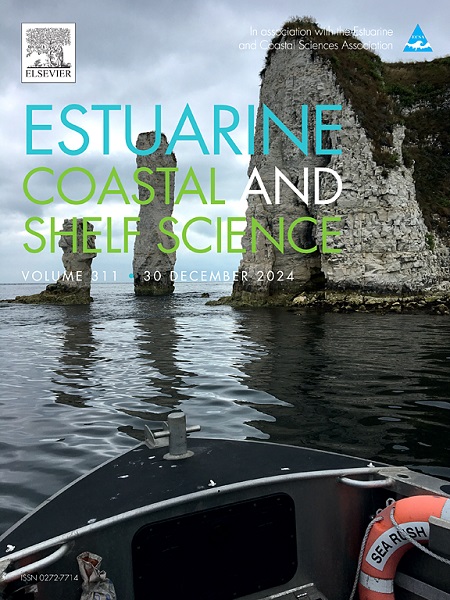Impact of storm surge and power peaking on tidal-fluvial processes in microtidal Neretva River estuary
IF 2.6
3区 地球科学
Q1 MARINE & FRESHWATER BIOLOGY
引用次数: 0
Abstract
This study investigates the interactions between tides, storm surge, river flow, and power peaking in the microtidal Neretva River estuary, Croatia. Based on the existing NS_Tide tool, the study proposes a new non-stationary harmonic model adapted for microtidal conditions, which incorporates linear storm surge, as well as linear and quadratic river discharge terms. This model enhances the NS_Tide’s ability to accurately predict water levels from tide-dominated sections downstream to discharge-dominated areas upstream. River discharge was identified as the dominant factor for predicting stage levels at most stations, while the influence of storm surge, though consistent, decreased upstream. Strong tide-river interactions were observed throughout the study domain, with the stationary tidal component consistently contributing to water level fluctuations at all location and minimal influence from the tide-surge interaction component. Simulations using the STREAM numerical model were also used to isolate the variability in water levels caused by power peaking. These simulations demonstrated that high-frequency discharge fluctuations due to hydropower plant operations amplify the constituent in upstream river sections and modulate the amplitudes of other tidal constituents in the estuarine and tidal river sections. The proposed method proved highly effective in the microtidal context of the Neretva River and shows potential for adaptation to mesotidal and macrotidal systems.

风暴潮和功率调峰对纳雷特瓦河口微潮潮-河流过程的影响
本研究调查了潮汐、风暴潮、河流流量和克罗地亚内雷特瓦河河口微潮的电力峰值之间的相互作用。在现有的NS_Tide工具的基础上,提出了一种新的适应小潮条件的非平稳调和模型,该模型考虑了线性风暴潮、线性和二次河流流量项。该模型提高了NS_Tide对下游潮控区至上游排流控制区水位的准确预测能力。在大多数站点,河流流量是预测水位的主导因素,而风暴潮的影响虽然一致,但在上游有所下降。在整个研究区域都观察到强烈的潮汐-河流相互作用,稳定的潮汐分量对所有地点的水位波动的贡献一致,而潮汐-浪涌相互作用分量的影响最小。使用STREAM数值模型的模拟也被用于分离由功率峰值引起的水位变化。这些模拟结果表明,水电站运行引起的高频流量波动放大了上游河段S1分量,并调节了河口和潮汐河段其他潮汐分量的振幅。该方法在Neretva河的小潮环境中非常有效,并显示出适应中潮和大潮系统的潜力。
本文章由计算机程序翻译,如有差异,请以英文原文为准。
求助全文
约1分钟内获得全文
求助全文
来源期刊
CiteScore
5.60
自引率
7.10%
发文量
374
审稿时长
9 months
期刊介绍:
Estuarine, Coastal and Shelf Science is an international multidisciplinary journal devoted to the analysis of saline water phenomena ranging from the outer edge of the continental shelf to the upper limits of the tidal zone. The journal provides a unique forum, unifying the multidisciplinary approaches to the study of the oceanography of estuaries, coastal zones, and continental shelf seas. It features original research papers, review papers and short communications treating such disciplines as zoology, botany, geology, sedimentology, physical oceanography.

 求助内容:
求助内容: 应助结果提醒方式:
应助结果提醒方式:


